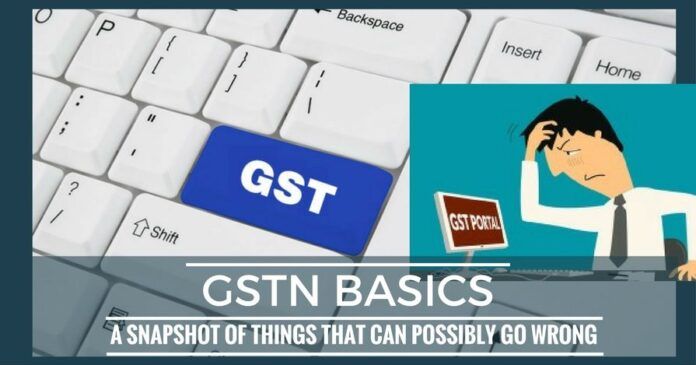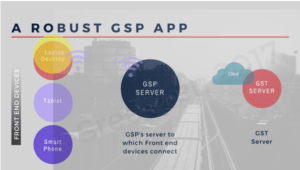
Looking into the future, can the GSTN Server design be enhanced such that it will last and scale for the next decade?
In its first avatar, GSTN tries to provide a simple Tax interface to tax professionals and Government departments such as the Income Tax, Central Board of Excise and Customs (CBEC) and State Tax Departments[1].
Figure 1 is a demonstration of how a third party can design their software/ application to talk to the GST Server. All such applications are grouped into a category that GSTN refers to as GST Suvidha Provider (GSP). In the above figure, the GSP application has its own server, which in turn connects to the GST Server in a Secure manner (think of it like a user buying goods from Amazon online store. An observant user will see a lock at the beginning of the site link to denote that the connection is secure[2]). As a rule, I would recommend that you only visit secure sites on the web. These will start with https:// instead of http://. GSTR1, GSTR2 etc. are standard terms used to denote specific functions; GSTR1 refers to data of Outward supplies of goods and services and is a form that needs to be filled electronically. Similarly GSTR2 refers to details of Inward supplies of goods and services, also a form[3].
 Figure 1. Typical GSP interface for third-party developers
Figure 1. Typical GSP interface for third-party developers
While it is possible to manually fill in these forms and submit them to the GSTN servers, it is highly recommended that all vendors use computerized GSP applications to automate this process. This will minimize errors, save time and cost and also keep track of records. This alone will create a lot of jobs for programming, data entry and so on. GSTN has provided a useful slide deck[4] that describes how the typical use cases will be for GSPs from Slide 12 onwards.
A well designed GSP app would show the tax information to the accountant, the status of various carriers to the logistics person, and so on.
A robust GSP would be able to display on many devices such as a Laptop, a Desktop, a Tablet or a Smartphone. All of these come with their own display sizes and features and therefore the GSP software that renders data on these devices needs to be smart about the device it is talking to. Many Open Source frameworks exist today that can form a starting point for simple GSP applications. Different departments will need to look at different aspects of a company’s operations. A well designed GSP app would show the tax information to the accountant, the status of various carriers to the logistics person, information on where the raw materials are for the production person and so on. Figure 2 shows a typical GSP that would perform such functions. In this instance, all the devices use Wi-Fi network to connect to their server (GSP Server). The GSP Server itself uses any of the connectivity interfaces such as Ethernet/ Fiber/ Satellite etc. to connect securely to the GST Server. This is the preferred configuration for most GSP apps.
 Figure 2. A Robust GSP application software
Figure 2. A Robust GSP application software
As mentioned before, all companies big and small will need to automate their processes. Many Open Source Software tools (meaning free) are available for this. What is required is basic programming skills in these tools. Skills that are required for these jobs experience in client standards such as HyperText Markup Language V5 (HTML5)/ Cascading Style Sheets V3 (CSS3), server-side tools such as Javascript, Javascript Object Notation (JSON) and a Content Management System such as WordPress, using which GSPs can be quickly put together. While text-based forms will work, it is recommended that Comma Separated Variables form of Excel spreadsheets be used for storing/ submitting data. While this is a good first step, the servers should allow encrypted binary data for speed.
These skills are not just for those with a Computer Science background – anyone can get proficient within a small period of time to be able to start such apps. Note that the programming skills are in addition to core competencies such as scientists/ chemists/ physicians/ researchers/ mathematicians etc. Welcome to the jobs of the future where one has to combine a multitude of disciplines to get the best out of your career. And we are just getting started!
The entire tax amount paid now currently gets accumulated at GSTN’s own banks, giving them a big float of money that they can arguably use for other purposes.
CURRENT GSTN LIMITATIONS
There is a proverb that says that one has to learn to walk first before one can run. The way GSTN API is designed today, it can at best automate the reporting of taxes by various entities to a central source for processing and disbursement of tax revenues. What are the ways this back-end software can be enhanced for the e-Trade of the future? Let us look at some of the challenges:
- Certification of the content of the goods – for instance, how will the tax calculation be made? What prevents a vendor from declaring a lower tax for transporting the goods and then tacking on a higher tax slab at the retail point? There has to be an independent checking and validation of the goods with proof of shipment from the point of origin to the destination so the two can match.
- How does one ensure that the goods have not tampered along the way?
- If shipment needs to be split from one source to several destinations, how does each of the split shipment get accounted?
- The entire tax amount paid now currently gets accumulated at GSTN’s own banks, giving them a big float of money that they can arguably use for other purposes. The time money spends at GSTN waiting to be distributed should be minimized. At this time, there is no provision to ensure this.
- New services such as Refrigerated Trucks[5] (reefers) will become popular as the need arises to transport Pharmaceutical products, fine antiques, personal care products in addition to perishable commodities such as Vegetables, Fish etc. When these become fully operational under GSTN, a lot of logistics have to be addressed – what happens when the product being carried goes bad because of truck breakdown or road mishap or flood and other natural disasters?
- Broadly failures due to pilferage, fraud, theft and ownership disputes are not addressed in this version.
WHAT IS THE WAY OUT?
Can these shortcomings be overcome? The above list is just a snapshot of things that can possibly go wrong and as GST is deployed, there will be much more. Looking into the future, can the GSTN Server design be enhanced such that it will last and scale for the next decade? Fortunately, there is an answer and that is to have GSTN embrace Distributed Ledger Technology into its architecture.
[1] GST GSTN Website – Front end design
[2] Amazon.com Link and sign of a secure connection
[3] GSTR1, GSTR2 Explanation of various forms used in reporting GST data
[4] GSTN GSP Implementation Framework
[5] Refrigerated trucks haul more than just perishables by Tom Kampf
- Indian Parliament’s Special Session is convened to mark the shifting to new Parliament building - September 3, 2023
- Why did Rajat Sharma of India TV not declare that Adani owns more than 16% shares in his channel? - January 29, 2023
- Prannoy Roy to get Rs.605 crore from Adani as per Stock Exchange filing. Why is Income Tax not acting on Roys’ dues of over Rs.800 crore? - January 4, 2023











PRESENT STATE OF GST IS SIMILAR TO VAT SINCE GSTR2 AND GSTR3 HAS BEEN WITHDRAWN…